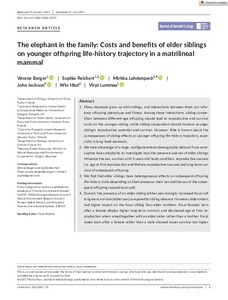The elephant in the family: Costs and benefits of elder siblings on younger offspring life-history trajectory in a matrilineal mammal
Berger Vérane; Reichert Sophie; Lahdenperä Mirkka; Jackson John; Htut Win; Lummaa Virpi
The elephant in the family: Costs and benefits of elder siblings on younger offspring life-history trajectory in a matrilineal mammal
Berger Vérane
Reichert Sophie
Lahdenperä Mirkka
Jackson John
Htut Win
Lummaa Virpi
Wiley-Blackwell Publishing Ltd.
Julkaisun pysyvä osoite on:
https://urn.fi/URN:NBN:fi-fe2021093048410
https://urn.fi/URN:NBN:fi-fe2021093048410
Tiivistelmä
- Many mammals grow up with siblings, and interactions between them can influence offspring phenotype and fitness. Among these interactions, sibling competition between different-age offspring should lead to reproductive and survival costs on the younger sibling, while sibling cooperation should improve younger sibling's reproductive potential and survival. However, little is known about the consequences of sibling effects on younger offspring life-history trajectory, especially in long-lived mammals.
- We take advantage of a large, multigenerational demographic dataset from semi-captive Asian elephants to investigate how the presence and sex of elder siblings influence the sex, survival until 5 years old, body condition, reproductive success (i.e. age at first reproduction and lifetime reproductive success) and long-term survival of subsequent offspring.
- We find that elder siblings have heterogeneous effects on subsequent offspring life-history traits depending on their presence, their sex and the sex of the subsequent offspring (named focal calf).
- Overall, the presence of an elder sibling (either sex) strongly increased focal calf long-term survival (either sex) compared to sibling absence. However, elder sisters had higher impact on the focal sibling than elder brothers. Focal females born after a female display higher long-term survival, and decreased age at first reproduction when raised together with an elder sister rather than a brother. Focal males born after a female rather than a male showed lower survival but higher body weight when both were raised together. We did not detect any sibling effects on the sex of the focal calf sex, survival until 5 years old and lifetime reproductive success.
- Our results highlight the general complexity of sibling effects, but broadly that elder siblings can influence the life-history trajectory of subsequent offspring. We also stress the importance of considering all life stages when evaluating sibling effects on life trajectories.
Kokoelmat
- Rinnakkaistallenteet [27094]
